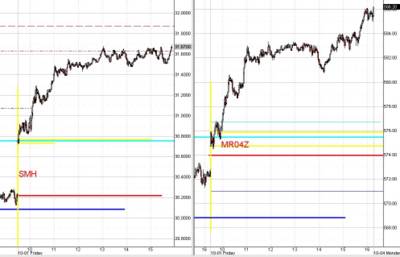
One of the most difficult aspects of human nature in trading is dealing with being wrong. And nothing affects your intraday daytrading more than having a trend prejudice as to what the market is supposed to do in the longer term time frame. Note yesterday's blog entry of Thursday, September 30. Using divergence, pattern and relative price, a valid sell signal for an end-of-day swing position was created at the close. According to this signal, today the market should have finished down, giving a swing position a profit, regardless of whether it started the day by going up or not. But this morning's action was giving three very important signals that a uptrending day was at hand for long intraday daytrade positions. But with a commitment to the short side already in place from last night's close, would you be able to even see these signals, let alone act on them? Probably not. In fact, with a position already committed in the longer term in the opposite direction, the probabilities are very high that your psyche will suffer from trend prejudice all day, adversely infecting your daytrade decisions. And if you're trading with leveraged index mutual funds for the longer time frame, you may not be able to liquidate the position immediately. And as for a possible intraday daytrade position, you might find your internal voice saying something like "I can't take a long position in the nearest time frame while I believe the longer time frame is going to be bearish. I can't trade against myself!" And indeed, perhaps you cannot. If you are this type of trader, and want to approach each day with the open mind necessary to decipher intraday trend direction, then you must consider parting with your end-of-day swing positions altogether. If there's anything that infects your daytrading with a trend prejudice in either direction prior to the signals actually taking shape, then that thing is going to cost you your precious trading capital quickly. Get rid of that thing immediately. Your success as a daytrader will depend on it. Read Part II of the Valhalla trading manual titled Self Recognition, and come join us each day and see how we handle our mistakes at daytradingmethods.com.








